Table of Contents
Chemistry has a direct impact on our lives and has a wide range of applications in different fields. These are given below:
(A) In Agriculture and Food:
(i) It has provided chemical fertilizers such as urea, calcium phosphate, sodium nitrate, ammonium phosphate etc.
(ii) It has helped to protect the crops from insects and harmful bacteria, by the use ‘ of certain effective insecticides, fungicides and pesticides.
(iii) The use of preservatives has helped to preserve food products like jam, butter, squashes etc. for longer periods.
(B) In Health and Sanitation:
(i) It has provided mankind with a large number of life-saving drugs. Today, dysentery and pneumonia are curable due to the discovery of sulpha drugs and penicillin life-saving drugs. Cisplatin and taxol are very effective for cancer therapy and AZT (Azidothymidine) is used for AIDS victims.
(ii) Disinfectants such as phenol are used to kill the micro-organisms present in drains, toilets, floors etc.
(iii) A low concentration of chlorine i.e., 0.2 to 0.4 parts per million (ppm) is used ’ for sterilization of water to make it fit for drinking purposes.
(C) Saving the Environment:
Rapid industrialisation all over the world has resulted in a lot of pollution.
Poisonous gases and chemicals are being constantly released into the atmosphere. They are polluting the environment at an alarming rate. Scientists are working day and night to develop substitutes that may cause lower pollution. For example, CNG
(Compressed Natural Gas), a substitute for petrol, is very effective in checking pollution caused by automobiles.
(D) Application in Industry:
Chemistry has played an important role in developing many industrially ^ manufactured fertilizers, alkalis, acids, salts, dyes, polymers, drugs, soaps, detergents, metal alloys and other inorganic and organic chemicals including new materials contribute in a big way to the national economy.\
Matter
- Anything which has mass and occupies space is called matter.
- For example, books, pencils, water, air are composed of matter as we know that they have mass and they occupy space.
Classification of Matter
There are two ways of classifying the matter:
(A) Physical classification
(B) Chemical classification
(A) Physical Classification:
Matter can exist in three physical states:
- Solids: The particles are held very close to each other in an orderly fashion and there is not much freedom of movement. Characteristics of solids: Solids have definite volume and definite shape.
- Liquids: In liquids, the particles are close to each other but can move around. Characteristics of liquids: Liquids have definite volume but no definite shape.
- Gases: In gases, the particles are far apart as compared to those present in solid or liquid states. Their movement is easy and fast.
Characteristics of Gases: Gases have neither definite volume nor definite shape. They completely occupy the container in which they are placed.
(B) Chemical Classification:
Based upon the composition, matter can be divided into two main types:
1. Pure substances: A pure substance may be defined as a single substance (or matter) that cannot be separated by simple physical methods. Pure substances can be further classified as (i) Elements (ii) Compounds
(i) Elements: An element consists of only one type of particle. These particles may be atoms or molecules. For example, sodium, copper, silver, hydrogen, oxygen etc. are some examples of elements. They all contain atoms of one type. However, atoms of different elements are different. Some elements such as sodium . or copper contain single atoms held together as their constituent particles whereas in some others two or more atoms combine to give molecules of the element. Thus, hydrogen, nitrogen and oxygen gases consist of molecules in which two atoms combine to give the respective molecules of the element.
(ii) Compounds: It may be defined as a pure substance containing two or more elements combined in a fixed proportion by weight and can be decomposed into these elements by suitable chemical methods. Moreover, the properties of a compound are altogether different from the constituting elements. The compounds have been classified into two types. These are:
(i) Inorganic Compounds: These are compounds that are obtained from non-living sources such as rocks and minerals. A few
examples are Common salt, marble, gypsum, washing soda etc.
(ii) Organic Compounds are the compounds that are present in plants and animals. All the organic compounds have been found to contain carbon as their essential constituent. For example, carbohydrates, proteins, oils, fats etc.
2. Mixtures: The combination of two or more elements or compounds that are not chemically combined and may also be present in any proportion, is called mixture. A few examples of mixtures are milk, seawater, petrol, lime water, paint glass, cement, wood etc.
Types of mixtures
Mixtures are of two types:
(i) Homogeneous mixtures: A mixture is said to be homogeneous if it has a uniform composition throughout and there are no visible boundaries of separation between the constituents. For example, A mixture of sugar solution in water has the same sugar water composition throughout and all portions have the same sweetness.
(ii) Heterogeneous mixtures: A mixture is said to be heterogeneous if it does not have uniform composition throughout and has visible boundaries of separation between the various constituents. The different constituents of a heterogeneous mixture can be seen even with the naked eye.
For example: When iron filings and sulphur powder are mixed, the mixture formed is heterogeneous. It has a greyish-yellow appearance and the two constituents, iron and sulphur, can be easily identified with the naked eye.
Differences between Compounds and Mixtures
Compounds
- In a compound, two or more elements are combined chemically.
- In a compound, the elements are present in the fixed ratio by mass. This ratio cannot change.
- CompoUnds are always homogeneous i.e., they have the same composition throughout.
- In a compound, constituents cannot be separated by physical methods
- In a compound, the constituents lose their identities i.e., the I compound does not show the characteristics of the constituting elements.
Mixtures
- In a mixture, or more elements or compounds are simply mixed and not combined chemically.
- In a mixture the constituents are not present in a fixed ratio. It can vary Mixtures may be either homogeneous or heterogeneous.
- Constituents of mixtures can be separated by physical methods.
- In a mixture, the constituents do not lose their identities i.e., a mixture shows the characteristics of all the constituents. We have discussed the physical and chemical classification of matter. A flowsheet representation of the same is given below.
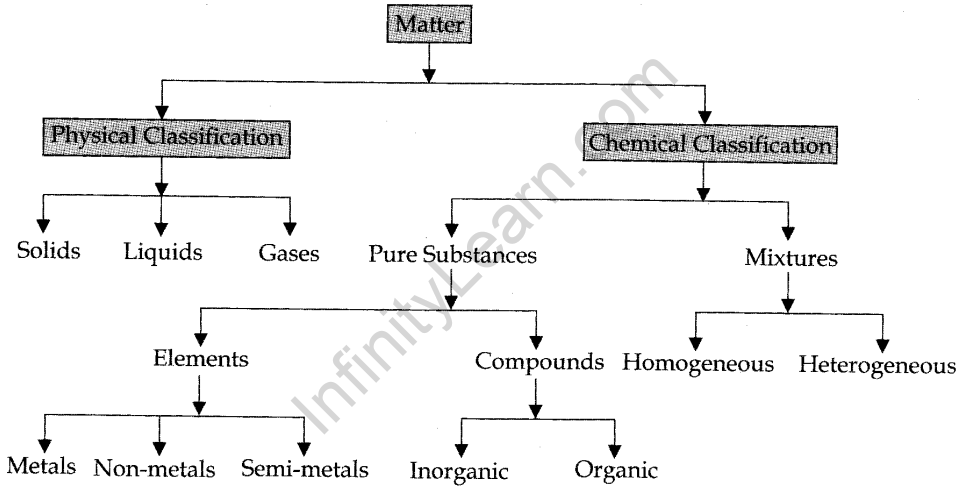
Properties of Matter and Their Measurements
Physical Properties: Those properties which can be measured or observed without changing the identity or the composition of the substance. Some examples of physical properties are colour, odour, melting point, boiling point etc. Chemical
Properties: It requires a chemical change to occur. The examples of chemical properties are characteristic reactions of different substances. These include acidity, basicity, combustibility etc.
Units of Measurement
Fundamental Units: The quantities mass, length and time are called fundamental quantities and their units are known as fundamental units. There are seven basic units of measurement for the quantities: length, mass, time, temperature, amount of substance, electric current and luminous intensity.
Si-System: This system of measurement is the most common system employed throughout the world. It has given units of all the seven basic quantities listed above.
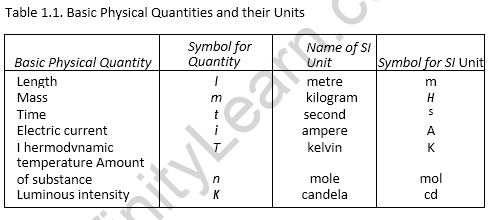
Definitions of Basic SI Units
- Metre: It is the length of the path travelled by light in a vacuum during a time interval of 1/299792458 of a second.
- Kilogram: It is the unit of mass. It is equal to the mass of the international prototype of the kilogram. ,
- Second: It is the duration of 9192631, 770 periods of radiation which correspond to the transition between the two hyperfine levels of the ground state of caesium- 133 atoms.
- Kelvin: It is the unit of thermodynamic temperature and is equal to 1/273.16 of the thermodynamic temperature of the triple point of water.
- Ampere: The ampere is that constant current which if maintained in two straight parallel conductors of infinite length, of negligible circular cross-section and placed, 1 metre apart in vacuum, would produce between these conductors a force equal to 2 x 10-7 N per metre of length.
- Candela: It may be defined as the luminous intensity in a given direction, from a source that emits monochromatic radiation of frequency 540 x 1012 Hz and that has a radiant intensity in that direction of 1/ 683 watt per steradian.
- Mole: It is the amount of substance that contains as many elementary entities as there are atoms in 0.012 kilograms of carbon -12. Its symbol is ‘mol’.
Mass and Weight
- Mass: Mass of a substance is the amount of matter present in it.
- The mass of a substance is constant.
- The mass of a substance can be determined accurately in the laboratory by using an analytical balance. SI unit of mass is the kilogram.
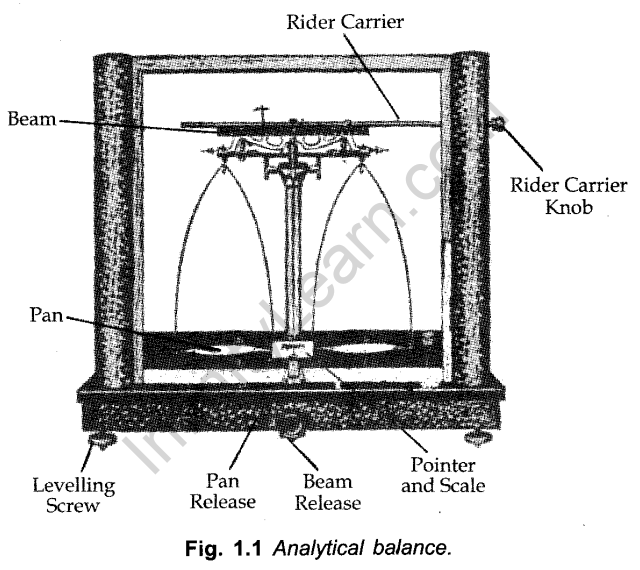
Weight: It is the force exerted by gravity on an object. The weight of a substance may vary from one place to another due to a change in gravity.
Volume: Volume means the space occupied by matter. It has units of (length)3. In SI units, volume is expressed in metre3 (m3). However, a popular unit of measuring volume, particularly in liquids is the litre (L) but it is not in SI units or an S.I. unit.
Mathematically,
1L = 1000 mL = 1000 cm3 = 1dm3. The volume of liquids can be measured by different devices like burette, pipette, cylinder, measuring flask etc. All of them have been calibrated.
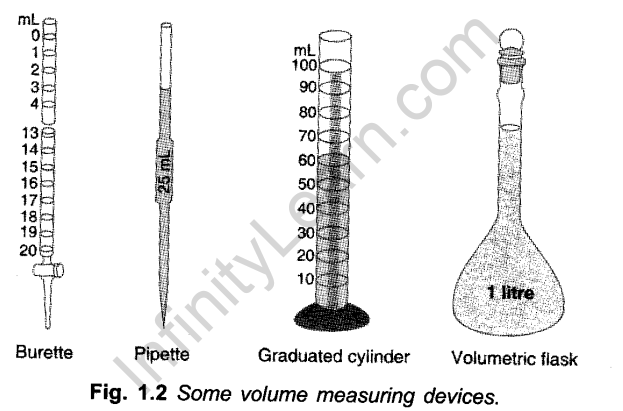
Temperature: There are three scales on which temperature can be measured. These are known as the Celsius scale (°C), Fahrenheit scale (°F) and Kelvin scale (K).
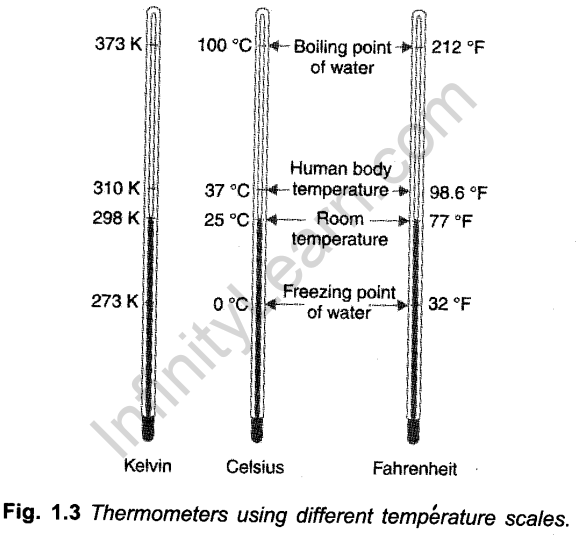
Thermometres with Celsius scale is calibrated from 0°C to 100°C.
Thermometres with Fahrenheit scale is calibrated from 32°F to 212°F.
Kelvin’scale of temperature is S.I. scale and is very common these days. The temperature on this scale is shown by the sign K.
The temperature on two scales are related to each other by the relationship

Density: The density of a substance is its amount of mass per unit volume. So, the SI unit of density can be obtained as follows:

This unit is quite large and a chemist often expresses density in g cm3 where mass is expressed in gram and volume is expressed in cm3.
• Uncertainty in Measurements
All scientific measurements involve a certain degree of error or uncertainty. The errors which arise depend upon two factors.
(i) Skill and accuracy of the worker (ii) Limitations of measuring instruments.
• Scientific Notation
It is an exponential notation in which any number can be represented in the form N x 10n where n is an exponent having positive or negative values and N can vary between 1 to 10. Thus, 232.508 can be written as 2.32508 x 102 in scientific notation.
Now let us see how calculations are carried out with numbers expressed in scientific notation.
(i) Calculation involving multiplication and division

(ii) Calculation involving addition and subtraction: For these two operations, the first numbers are written in such a way that they have the same exponent. After that, the coefficients are added or subtracted as the case may be. For example,
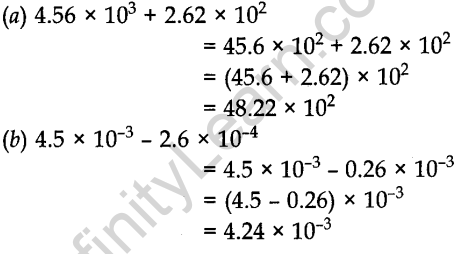
• Significant Figures
Significant figures are meaningful digits that are known with certainty. There are certain rules for determining the number of significant figures. These are stated below:
1. All non-zero digits are significant. For example, in 285 cm, there are three significant figures and in 0.25 mL, there are two significant figures.
2. Zeros preceding to first non-zero digit are not significant. Such zeros indicate the position of the decimal point.
For example, 0.03 has one significant figure and 0.0052 has two significant figures.
3. Zeros between two non-zero digits are significant. Thus, 2.005 has four significant figures.
4. Zeros at the end or right of a number are significantly provided they are on the right side of the decimal point. For example, 0.200 g has three significant figures.
5. Counting numbers of objects. For example, 2 balls or 20 eggs have infinite significant figures as these are exact numbers and can be represented by writing an infinite number of zeros after placing a decimal.
i.e., 2 = 2.000000
or 20 = 20.000000
• Addition and Subtraction of Significant Figures
In addition or subtraction of the numbers having different precisions, the final result should be reported to the same number of decimal places as in the term having the least number of decimal places.
For example, let us carry out the addition of three numbers 3.52, 2.3 and 6.24, having different precisions or a different number of decimal places.
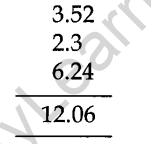
The final result has two decimal places but the answer has to be reported only up to one decimal place, i.e., the answer would be 12.0.
Subtraction of numbers can be done in the same way as an addition.
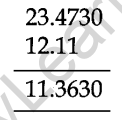
The final result has four decimal places. But it has to be reported only up to two decimal places, i.e., the answer would be 11.36.
• Multiplication and Division of Significant Figures
In the multiplication or division, the final result should be reported up to the same number of significant figures as present in the least precise number.
Multiplication of Numbers: 2.2120 x 0.011 = 0.024332
According to the rule the final result = 0.024
Division of Numbers: 4.2211÷3.76 = 1.12263
The correct answer = 1.12
• Dimensional Analysis
Often while calculating, there is a need to convert units from one system to other. The method used to accomplish this is called the factor label method or unit factor method or dimensional analysis.
• Laws of Chemical Combinations
The combination of elements to form compounds is governed by the following five basic laws.
(i) Law of Conservation of Mass
(ii) Law of Definite Proportions
(iii) Law of Multiple Proportions
(iv) Law of Gaseous Volume (Gay Lussac’s Law)
(v) Avogadro’s Law
(i) Law of Conservation of Mass
The law was established by a French chemist, A. Lavoisier. The law states:
In all physical and chemical changes, the total mass of the reactants is equal to that of the products.
In other words, matter can neither be created nor destroyed.
The following experiments illustrate the truth of this law.
(a) When matter undergoes a physical change.

It is found that there is no change in weight though a physical change has taken place.
(b) When matter undergoes a chemical change.
For example, decomposition of mercuric oxide.

During the above decomposition reaction, the matter is neither gained nor lost.
(ii) Law of Definite Proportions
According to this law:
A pure chemical compound always consists of the same elements combined in a fixed proportion by weight.
For example, Carbon dioxide may be formed in several ways i.e.,

(iii) Law of Multiple Proportions
If two elements combine to form two or more compounds, the weight of one of the elements which combine with a fixed weight of the other in these compounds bears a simple whole-number ratio by weight.
For example,

(iv) Gay Lussac’s Law of Gaseous Volumes
The law states that, under similar conditions of temperature and pressure, whenever gases combine, they do so in volumes that bear a simple whole-number ratio with each other and also with the gaseous products. The law may be illustrated by the following examples.
(a) Combination between hydrogen and chlorine:

(b) Combination between nitrogen and hydrogen: The two gases lead to the formation of ammonia gas under suitable conditions. The chemical equation is

(v) Avogadro’s Law: Avogadro proposed that equal volumes of gases at the same temperature and pressure should contain an equal number of molecules.
For example,
If we consider the reaction of hydrogen and oxygen to produce water, we see that two volumes of hydrogen combine with one volume of oxygen to give two volumes of water without leaving any unreacted oxygen.
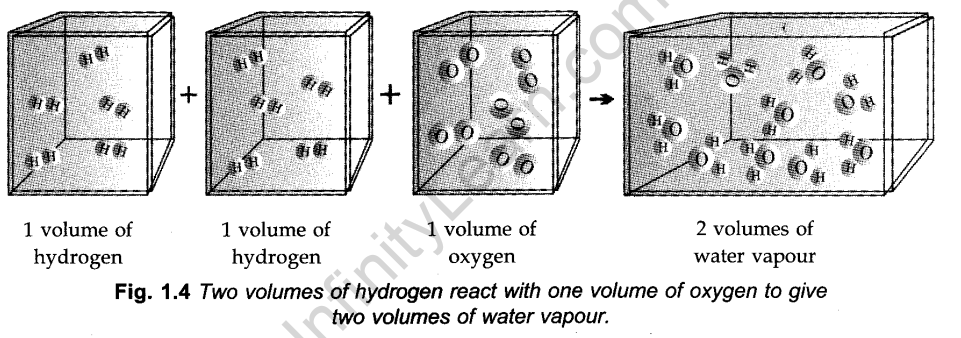
• Dalton’s Atomic Theory
In 1808, Dalton published ‘A New System of Chemical Philosophy’ in which he proposed the following:
1. Matter consists of indivisible atoms.
2. All the atoms of a given element have identical properties including identical mass. Atoms of different elements differ in mass.
3. Compounds are formed when atoms of different elements combine in a fixed ratio.
4. Chemical reactions involve the reorganisation of atoms. These are neither created nor destroyed in a chemical reaction.
• Atomic Mass
The atomic mass of an element is the number of times an atom of that element is heavier than an atom of carbon taken as 12. It may be noted that the atomic masses as obtained above are the relative atomic masses and not the actual masses of the atoms.
One atomic mass unit (AMU) is equal to l/12th of the mass of an atom of the carbon-12 isotope. It is also known as a unified mass.
Average Atomic Mass
Most of the elements exist as isotopes which are different atoms of the same element with different mass numbers and the same atomic number. Therefore, the atomic mass of an element must be its average atomic mass and it may be defined as the average relative mass of an atom of an element as compared to the mass of carbon atoms (C-12) taken as 12w.
Molecular Mass
Molecular mass is the sum of the atomic masses of the elements present in a molecule. It is obtained by multiplying the atomic mass of each element by the number of its atoms and adding them together.
For example,
The molecular mass of methane (CH4)
= 12.011 u + 4 (1.008 u)
= 16.043 u
Formula Mass
Ionic compounds such as NaCl, KNO3, Na2C03 etc. do not consist of molecules i.e., single entities but exist “as ions closely packed together in a three-dimensional space as shown in -Fig. 1.5.
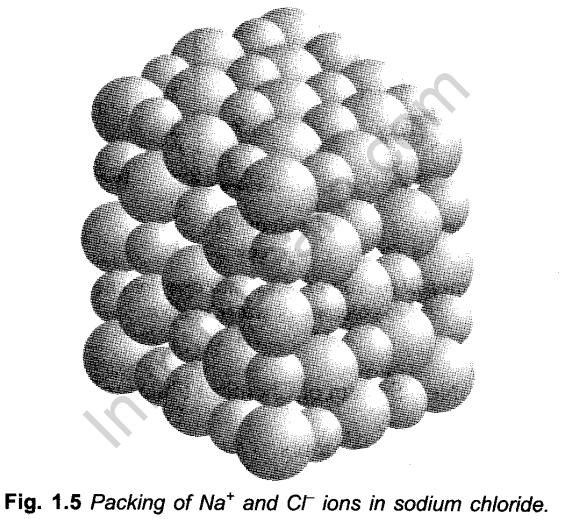
In such cases, the formula is used to calculate the formula mass instead of molecular mass. Thus, formula mass of NaCl = Atomic mass of sodium + atomic mass of chlorine
= 23.0 u + 35.5 u = 58.5 u.
• Mole Concept
It is found that one gram atom of any element contains the same number of atoms and one gram molecule of any substance contains the same number of molecules. This number has been experimentally determined and found to be equal to 6.022137 x 1023 The value is generally called Avogadro’s number or Avogadro’s constant.
It is usually represented by NA:
Avogadro’s Number, NA = 6.022 × 1023
• Percentage Composition
One can check the purity of a given sample by analysing this data. Let us understand by taking the example of water (H20). Since water contains hydrogen and oxygen, the percentage composition of both these elements can be calculated as follows:

• Empirical Formula
The formula of the compound gives the simplest whole-number ratio of the atoms of various elements present in one molecule of the compound.
For example, the formula of hydrogen peroxide is H202. To express its empirical formula, we have to take out a common factor 2. The simplest whole-number ratio of the atoms is 1:1 and the empirical formula is HO. Similarly, the formula of glucose is C6H1206. To get the simplest whole number of the atoms,
Common factor = 6
The ratio is = 1: 2: 1 The empirical formula of glucose = CH20
• Molecular Formula
The formula of a compound gives the actual ratio of the atoms of various elements present in one molecule of the compound.
For example, molecular formula of hydrogen peroxide = H202and Glucose = C6H1206
Molecular formula = n x Empirical formula
Where n is the common factor and is also called multiplying factor. The value of n maybe 1, 2, 3, 4, 5, 6 etc.
In case n is 1, the Molecular formula of a compound = the Empirical formula of the compound.
• Stoichiometry and Stoichiometric Calculations
The word ‘stoichiometry’ is derived from two Greek words—stoicheion (meaning element) and metron (meaning measure). Stoichiometry thus deals with the calculation of masses (sometimes volume also) of the reactants and the products involved in a chemical reaction. Let us consider the combustion of methane. A balanced equation for this reaction is as given below:
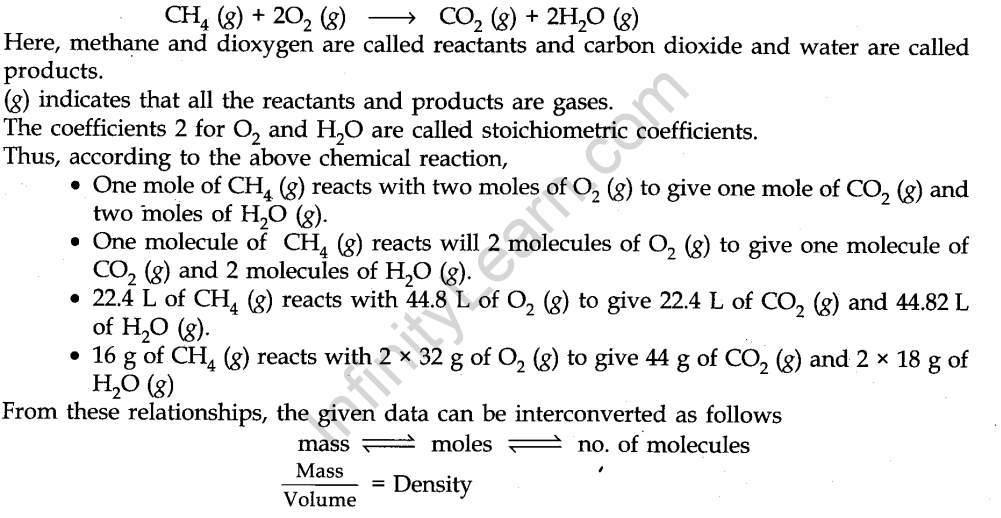
Limiting Reactant/Reagent
Sometimes, in the alchemical equation, the reactants present are not the amount required according to the balanced equation. The amount of products formed then depends upon the reactant which has reacted completely. This reactant which reacts completely in the reaction is called the limiting reactant or limiting reagent. The reactant which is not consumed completely in the reaction is called excess reactant.
Reactions in Solutions
When the reactions are carried out in solutions, the amount of substance present in its given volume can be expressed in any of the following ways:
1. Mass per cent or eight per cent (w/w%)
2. Mole fraction
3. Molarity
4. Molality
1. Mass per cent: It is obtained by using the following relation:

2. Mole fraction: It is the ratio of several moles of a particular component to the total number of moles of the solution. For a solution containing n2 moles of the solute dissolved in n1 moles of the solvent,
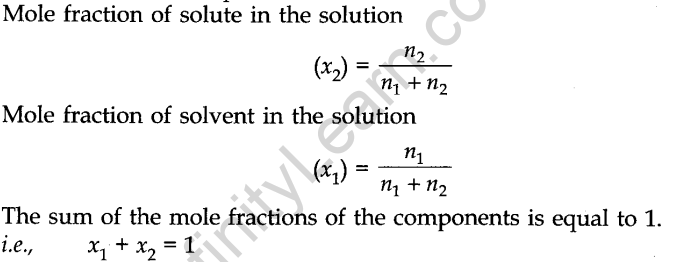
3. Molarity: It is defined as the number of moles of solute in 1 litre of the solution.

4. Molality: It is defined as the number of moles of solute present in 1 kg of solvent. It is denoted by m.

• All substances contain matter which can exist in three states — solid, liquid or gas.
• Matter can also be classified into elements, compounds and mixtures.
• Element: An element contains particles of only one type which may be atoms or molecules.
• Compounds are formed when atoms of two or more elements combine in a fixed ratio to each other.
• Mixtures: Many of the substances present around us are mixtures.
• Scientific notation: The measurement of quantities in chemistry are spread over a wide range of 10-31to 1023. Hence, a convenient system of expressing the number in scientific notation is used.
• Scientific figures: The uncertainty is taken care of by specifying the number of significant figures in which the observations are reported.
• Dimensional analysis: It helps to express the measured quantities in different systems of units.
• Laws of Chemical Combinations are:
(i) Law of Conservation of Mass
(ii) Law of Definite Proportions
(iii) Law of Multiple Proportions
(iv) Gay Lussac’s Law of Gaseous Volumes
(v) Avogadro’s Law.
• Atomic mass: The atomic mass of an element is expressed relative to the 12C isotope of carbon which has an exact value of 12u.
• Average atomic mass: Obtained by taking into account the natural abundance of different isotopes of that element.
• Molecular mass: The molecular mass of a molecule is obtained by taking the sum of atomic masses of different atoms present in a molecule.
• Avogadro number: The number of atoms, molecules or any other particles present in a given system is expressed in terms of the Avogadro constant.
= 6.022 x 1023
• Balanced chemical equation: A balanced equation has the same number of atoms of each element on both sides of the equation.
• Stoichiometry: The quantitative study of the reactants required or the products formed is called stoichiometry. Using stoichiometric calculations, the amounts of one or more reactants required to produce a particular amount of product can be determined and vice-versa.



